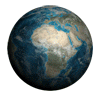Desert types
Deserts are dry places where little rain or snow falls. Some deserts get less than 25 mm (1 inch) of precipitation each year. Other deserts may get up to 250 mm (10 inches) of precipitation.
Cold deserts form at higher latitudes. The Patagonian desert in South America and the Gobi desert in Asia are cold deserts.
The map  shows the 25 largest deserts in the world.
shows the 25 largest deserts in the world.
Blue icons are cold deserts, orange are hot.
How many deserts can you name?
Deserts can form for many reasons
The Mojave and Great Basin deserts in North America are dry because they are in the rain shadow of the California coastal  mountain range.
mountain range.
Moist air is blown from the oceans up the side of the mountains where it rains and snows. By the time the air has crossed the mountains there is very little moisture left.

Click to view larger and see the legend.
As air is forced upward over the mountains, it cools, causing water vapour to condense and rain falls out
- Wet climate
- Air flow
- Warm wet air
- Rain shadow
- Dry air flows down and warms promoting evaporation
- Desert climate
Sometimes deserts can form between oceans and mountains. The Atacama desert in South America is dry because two air masses carrying little or no moisture meet and form dry stable conditions.
« Back 












